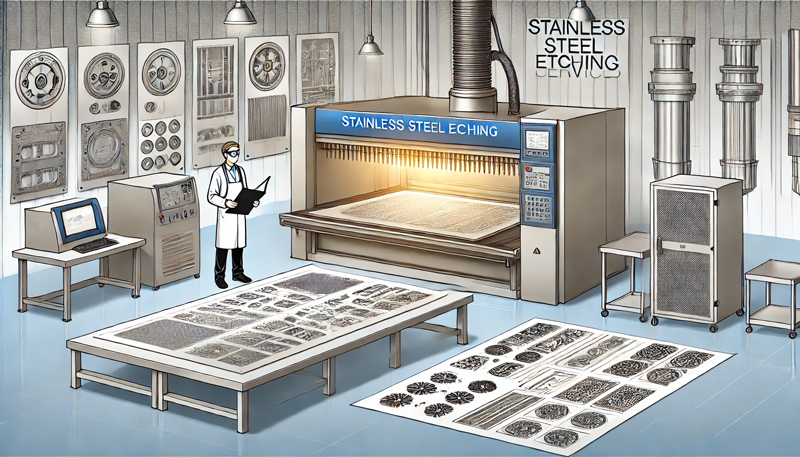
Chemical etching of stainless steel is a precise, cost-effective method used to create intricate patterns, markings, or designs on stainless steel surfaces by selectively removing material. This process is widely applied in industries like electronics, medical, automotive, and aerospace for creating components such as filters, screens, and decorative panels. Here’s an overview of the steps, chemicals used, and safety measures involved in the process.
Design Preparation: A stencil or resist pattern is created, usually using CAD software. This pattern will dictate which areas of the stainless steel are exposed to the etching solution.
Cleaning: The stainless steel surface must be cleaned thoroughly to remove any oils, contaminants, or oxidation. This ensures good adhesion for the resist material.
Applying the Resist Layer: A resist material, such as a photoresist or polymer film, is applied to the stainless steel. This material protects parts of the metal from being etched away. The resist can be applied by screen printing, photolithography, or lamination.
Exposing and Developing the Resist: For photolithography, the coated metal is exposed to UV light through a mask of the design. Exposed areas are then developed, leaving the desired pattern on the surface.
Etching: The metal is immersed in an etchant solution, often ferric chloride (FeCl₃), hydrochloric acid (HCl), or nitric acid (HNO₃), which selectively dissolves the exposed stainless steel areas. The concentration and temperature of the etchant, as well as immersion time, will affect the precision and depth of the etching.
Resist Removal: Once etching is complete, the remaining resist material is removed using a solvent or alkaline solution, revealing the final design on the stainless steel.
Rinsing and Drying: The metal is rinsed thoroughly to stop the etching reaction, then dried.
Ferric Chloride (FeCl₃): Commonly used due to its effectiveness and control in removing stainless steel.
Hydrochloric Acid (HCl): Often used to clean and prepare surfaces but can be used for etching when diluted.
Nitric Acid (HNO₃): Sometimes mixed with hydrochloric acid for stainless steel etching but is less common due to its high reactivity and difficulty in handling.
Proper Ventilation: Work in a well-ventilated area or under a fume hood to avoid inhaling toxic fumes.
Personal Protective Equipment (PPE): Wear gloves, goggles, and protective clothing to prevent contact with acids and chemical fumes.
Waste Disposal: Etchant solutions and rinse water must be disposed of according to local hazardous waste regulations, as they contain dissolved metals and chemicals harmful to the environment.
Precision: Can produce fine details, with tolerances often within a few micrometers.
Versatility: Works with various grades of stainless steel and can handle complex designs.
Non-Distorting: The chemical process does not involve mechanical force, so the material’s properties remain unaffected.
Chemical etching is ideal for applications where precision, repeatability, and high-quality finishes are essential.
Contact: andy_Lai
Phone: 18938693450
E-mail: yw9@zldsmt.com
Add: Building A3, Huafa Industrial Park, Fuyong Town, Fuyuan Road, Fuyong Town, Baoan District, Shenzhen,China